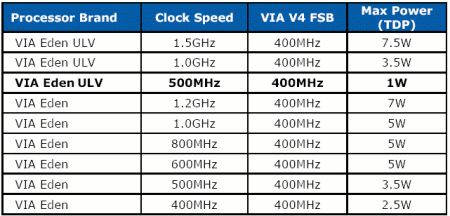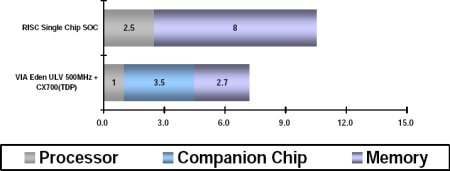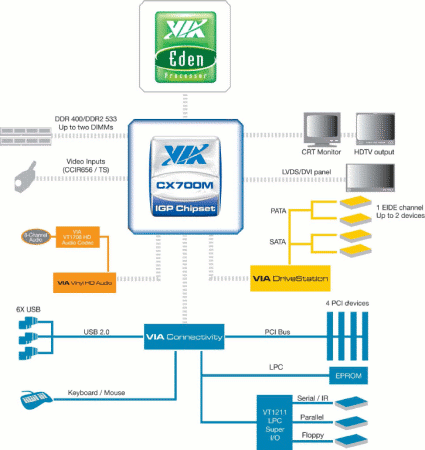Via aims 1W x86 CPU at mobile, embedded apps
Aug 23, 2007 — by LinuxDevices Staff — from the LinuxDevices Archive — 13 viewsTaiwanese chip and board vendor Via Technologies has introduced a new ultra-low voltage (ULV) processor aimed at industrial, commercial, and ultra-mobile applications. Touted as the “world's most power-efficient” x86-compatible CPU, the 500MHz Via Eden ULV processor debuted at an Embedded Systems Conference in Taipei this week.
digg this story |
“Eden” is Via's branding for its line of embedded processors, which target passively cooled applications in industrial equipment. Eden chips use the same “Esther” core found in Via's “C7” branded desktop and “C7-M” mobile processors. However, Eden parts are tested for higher-temperature operation, to better support passively-cooled applications. And, like Via's C7-M parts for mobile applications, they use a smaller 21mm-square package than the desktop parts.
Via launched its ULV line in March of 2006, offering ULV versions of both Eden and C7-M parts. Prior to today's launch of the 500MHz part, the Eden ULV line included parts clocked at 1GHz and at 1.5GHz, as shown in the chart below.

Via's current Eden and Eden ULV lineup
Via says its Eden ULV 500 draws a minimum of 0.1 Watts, when idle, and a maximum of 1 Watt. This puts the part below the TDPs (thermal design power, or total dissipated power) advertised by AMD for its LX line of low-power x86-compatible parts and shown in the following table.
| CPU | Clock | Typical Power | TDP |
|---|---|---|---|
| LX700 | 433MHz | ||
| LX800 | 500MHz | ||
| LX900 | 600MHz |
AMD's Geode LX line
The Eden ULV 500 probably uses more power than various 486- and Pentium-class SoCs (system-on-chip processors) available, however, such as the SIS550, ZFx86, STPC, and so on. However, the Eden part should offer much higher performance, thanks to support for MMX and SSE2 instructions, faster system and memory buses, larger caches, and so on.
The Eden ULV processor would typically be paired with Via's CX700M integrated northbridge/southbridge, which adds another 3.5 Watts to the power budget. However, the CX700M saves power by supporting more power-efficient DDR2 memory, Via points out. The chart below suggests the Eden ULV/CX700M combo can actually prove more power-efficient in large-memory systems than RISC-based SoCs that integrate processor and bridge functions on the same die.

Via Eden ULV system vs. RISC SoC with DDR RAM
(Click to enlarge)
Additionally, Via claims to have designed the CX700M companion chip so as to allow “each functional block to be individually disabled.” The projected power savings of disabling each block are listed in the table below.

Via CX700M power savings by block
(Click to enlarge)
The bottom line, according to Via, is that the 1-Watt Eden ULV 500 and 3.5-Watt CX700M companion chip can be used to build sub-10-Watt systems that nontheless support a wide range of multimedia, connectivity, and storage options.

Eden CPU and CX700M northbridge function diagram
(Click to enlarge)
Via claims that its Eden ULV processors have already been adopted by a long list of device, appliance, board, and low-cost system vendors, including AAEON, Acrosser, Adlink, Advansus, Advantech, Aquila, Arbor, Avalue, Axiomtek, Biostar, Bona, Boser, Commate, E-TOP, Flexus, Freetech, Ibase, IEI, Inhand, IPOX, Kontron, Lanner, Liantec, Maple, Nexcom, Posiflex, Portwell, Termtek, Unication, and Unicorn. Some of its customers are showing designs based on the 500MHz Eden part at ESC this week in Taipei, Via said.
Richard Brown, VP of corporate marketing, stated, “Driving PC technology into new markets defines our 'Small is Beautiful' strategy.”
Availability
No pricing or availability details were offered; however, the 500MHz Eden ULV part appears to be sampling.
Further details about the Eden ULV 500 can be found in a Via whitepaper entitled “The 1-Watt processor: making x86 more accessible to the embedded market,” and available here (PDF download).
This article was originally published on LinuxDevices.com and has been donated to the open source community by QuinStreet Inc. Please visit LinuxToday.com for up-to-date news and articles about Linux and open source.